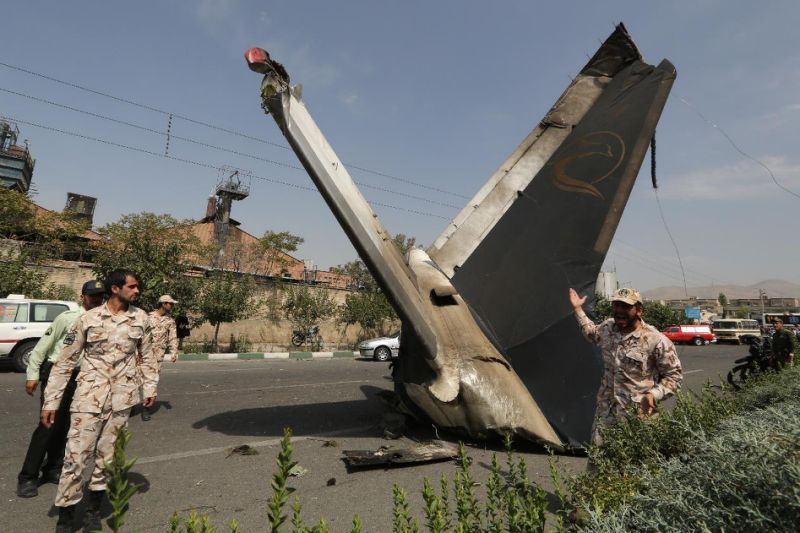February 26, 2021

Iran has announced its will resume production of the much-maligned Ukrainian-designed Antonov-140 aircraft, but only for use by the Iranian military and only as a cargo plane.
In the 1990s, Iran bought the rights to assemble the plane using an increasing amount of locally-made parts. It was to be Iran’s primary aircraft for short-distance domestic flights.
But Iran had great difficulty building it and produced very few models. Then the aircraft had safety problems. When a third plane crashed—this one into a boulevard just after taking off from Tehran’s Mehrabad Airport August 10, 2014 President Rohani halted the program entirely and grounded all the planes so far assembled. The crash killed 39 of those on the plane, but struck no one on the ground.
The aircraft were built at the HESA aircraft factory near Esfahan, a factory originally built by the US Bell Helicopter Co. for assembly of its helicopters.
The plane was named the An-140 in Ukraine. Iran dubbed the planes assembled in Iran as the IrAn-140.
The original contract called for Iran to assemble 80 planes with Ukraine making all the parts for the initial planes and then fewer parts as time progressed and Iran was able to make some of the parts itself. Production was to rise quickly to one plane per month. When Rohani stopped the project, only 14 planes were understood to have been made over 16 years inside Iran and three of them had crashed. All the crashes involved engine failures.
Touraj Dehqani-Zanganeh, head of the Iran Civil Aviation Organization, announced the resumption of the program February 19. It is understood that the Antonov company was displeased with the cancellation while it had a stock of parts ready to ship to Iran. The Ukrainian government likely made its anger known a year ago after Iran shot down a plane belonging to the Ukrainian state airline and may have demanded payments for canceling the An-140 contract.
Zanganeh was careful to say the plane would never be used for commercial passenger flights, but only for military cargo flights though that may not be very reassuring for military pilots.
Zanganeh did not say why HESA would now resume production, but there was speculation he concluded it was better to resume production than to face a suit for penalty payments for canceling the program. Rohani has not yet said anything about the resumed production.
Zanganeh also said Iran would launch production of a 100-seat passenger plane. He did not name the design, but Iran had previously been talking to both Antonov and some Russian aircraft manufacturers about buying rights to one of their 100-seat aircraft.
As a passenger plane, the An-140 can carry 52 passengers. It is a turboprop aircraft—that is, a propellor plane with the propellor driven by a turbine engine. It has a range of 900 kilometers (560 miles).
Of the 14 planes known to have been built by Iran, three crashed one during a test flight in 2009, one while being landed by Safiran Airlines in Arak in 2005, attributed to a failure of the fuel control system, and the last in 2014, when one of its two engines stopped just after takeoff. That plane was operated by Sepahan Airlines, which had been created to fly the IrAn-140s since no one else was then willing to buy them.
The An-140 was first flown in the Ukraine in 1997.
HESA (Iran Aircraft Manufacturing Industries) was founded in 1975 for the purpose of building Bell Helicopters. The plant had not been finished when the revolution rolled over Iran. The new regime killed the aircraft plant, as it killed many of the Shah’s other projects that the revolutionaries viewed as mere prestige projects—such as the Tehran Metro, the superhighway from Tehran to the Caspian Sea and the nuclear power program. As with those projects, however, the aircraft plant idea was revived in 1995 with the goal of making Iran a hub for building small planes to be sold all over the region.
Several companies, including Antonov, CASA, Ilyushin, Aerei da Trasporto Regionale (ATR), Tupolev and Saab, decided to, or were invited to, participate, but international sanctions and political pressure left Antonov as the sole candidate, according to FlightGlobal.
It said poor economic conditions in Ukraine meant that Antonov was ready to meet all of the Iranian government’s demands for licensed production of the An-140, even though production of the aircraft was still in its initial phase and the efficiency of the An-140 was unclear. Many Iranian civil and military aviation experts were against the project, believing that the government was risking much capital investing in an aircraft that had yet to fly. Ali-Akbar Hashemi-Rafsanjani was president when the deal was signed.
The obvious difficulty the government had turning out even a handful of low-tech turboprop aircraft raises obvious questions about its claims to be mass-producing Iranian-designed jet fighters at the HESA factory.
A Doctor Vaziri, identified as the head of IrAn-140 production, told Esfahan television in October 2006 that Iran was spending $14 million to produce each IrAn-140. The version of the An-140 made in Ukraine carried a list price of $6.7 million at that time.
Ukraine didn’t have much luck with its own An-140 planes. As of 2017, it had only built 35 of the planes and only one of them was in commercial service.
Azerbaijan ordered four of the An-140s. When one crashed in 2005, Azerbaijan grounded the second and canceled the order for the two others.






















